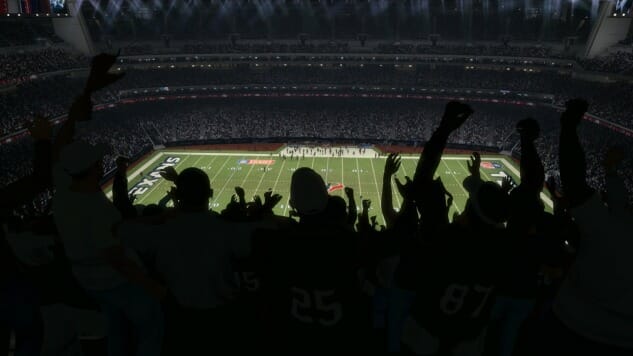Madden‘s Ultimate Team is More Proof That Football Isn’t About Football Anymore
Games Features Madden 17
The NFL’s 2015 season story wasn’t about Peyton Manning’s Super Bowl win or the fall of 49er’s QB Colin Kaepernick. It was instead Draft Kings and Fan Duel, two obnoxious gambling/not gambling services who inundated the commercial breaks of every NFL broadcast.
Draft Kings and Fan Duel, aside from their ad saturation, exist because of modern NFL fan culture. Passive spectators turned their fandom into a side economy. Fantasy leagues embed a competitive fiction to Sunday gameday. The illusory value of being a billionaire NFL owner trading, commanding and “owning” millionaires has its allure. Within the same ideology is Madden’s Ultimate Team, a reportedly $650 million annual business for publisher EA.
Beginning with FIFA 2009, the Ultimate Team feature quickly escalated into a mainstay, the result of that dream-like, pretend billionaire culture. It’s a distinctly American thing in terms of pro football, if seemingly stronger post-recession when this all took off. Built on the idea of artificial scarcity and tantalizing reward screens, Madden 17’s Ultimate Team reaches a crescendo. Pyrotechnics flare when menu surfing. There are flashing lights, tempting countdown clocks and shimmering gold borders, all reaching maximum gaudiness in Madden 17.
At its core, Ultimate Team is a harmless side show to Madden’s long standing particulars like season play or franchise. Ultimate Team creates packs of digital trading cards representing a customized team, asking users to play, improve and advance through pre-set challenges with said roster. Initial unlocks of some star players (past and present) lure and hook consumers in its grip. Specific packs of cards (with the promise of better rewards) lock themselves behind real money transactions. Prices range from $1.49 to the “best deal” at $99.99, $40 above Madden’s core retail price. Competitiveness is manufactured in line with card rarity.
Unlike personal fantasy leagues among friends (and penetrative success stories like Draft Kings), Ultimate Team promises no return on investment other than a digital card which represents a digital player on a digital leaderboard. Draft Kings’ gambling led to an uptick in legislative concerns. What would’ve happened if you couldn’t actually win anything for your money?
Briskly seeping into Madden’s culture in only six years, the ubiquitous Ultimate Team was able to absolve itself of any critical wrongdoing. It’s just a thing now. So it’s here and in 2K’s sports games as well, although without the same ardent fan devotion found with Madden’s version.
To their credit, EA’s Madden development crew (of which none of the above is in their control) crafted a wide-eyed, enthusiastic football videogame. In terms of both fundamentals and pro sports theatricality, Madden 17 fills both quotas.
Four years on from a half-finished, yearless Madden 25, this premiere pigskin series wears something resembling “next gen” promises. Consider the refreshed commentary, observant halftime shows, better between-play actions and deeper control options, especially with the ground game. Based primarily on the additions this year, Madden 17 is a rewarding update, if still playing catch up to NFL 2K5’s dozen year-old presentation. Not baby but toddler steps this year.
For purposes of authenticity, Madden 17’s presentation adds between-quarter commercials, simulating the broadcast feel. Pizza chain Papa John’s floods the screen, touting supposedly better (without context) ingredients. Head & Shoulders takes a special place as the NFL’s “official” haircare sponsor. On the sidelines, branded Gatorade coolers form a neon orange symposium. Coaches hold tightly their distinctively blue Microsoft Surface tablets. It’s as if the corporate sponsors created their own team colors.
The advertising isn’t the worst. The early internet connected Maddens on the Xbox 360 and PlayStation 3 plastered Snickers ads throughout the menu system. Those editions, however, weren’t funded by the extra income from Ultimate Team. (EA brings in about $650 million a year with Ultimate Team.) There’s something inherently crass in the corporate schmoozing of EA and Papa John’s in an annualized $60 product. They’ve banded together around a league shilling jerseys of domestic abusers, while in turn exploiting ferociously dedicated fans willing to bite on anything with a logo.
For pure authenticity, instead of pizza and shampoo, Madden needs Draft Kings. The NFL feels naked without them anymore. Ads with all-smiles 30-somethings telling a camera how much they win per week by playing—that’s the NFL now. Take away the commercialization, what’s left is just plain, ordinary football. By design, that’s not enough anymore.
Matt Paprocki has critiqued home media and videogames for 16 years. His current passion project is the technically minded DoBlu.com. You can follow Matt’s body of work via his personal WordPress blog, and follow him on Twitter @Matt_Paprocki.

